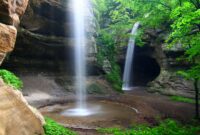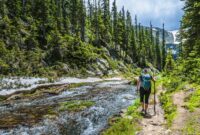Scenic trails near me offer a fantastic opportunity to connect with nature and enjoy the beauty of the surrounding environment. Whether you’re seeking a challenging hike with breathtaking mountain views, a leisurely stroll through a tranquil forest, or a relaxing bike ride along a scenic river, numerous options cater to diverse preferences and fitness levels. This guide helps you discover and navigate these local treasures, ensuring a safe and rewarding experience.
From identifying suitable trails based on your preferences – be it difficulty, length, or scenery type – to understanding essential safety measures and preparing adequately for your adventure, we cover all the bases. We’ll explore resources to find trails, discuss how to interpret reviews and ratings, and provide tips for enhancing your overall experience, such as incorporating photography or birdwatching into your journey. Ultimately, this guide aims to empower you to confidently explore the scenic trails in your vicinity.
Enhancing the Trail Experience
Exploring scenic trails offers a fantastic opportunity for recreation and connection with nature. However, simply walking the path can be elevated to a truly enriching experience through mindful engagement and planned activities. By incorporating specific pursuits, you can deepen your appreciation for the natural world and create lasting memories.
Activities to Enhance the Scenic Experience
Engaging in specific activities while on a scenic trail can transform a simple walk into a multi-sensory adventure. These activities offer a way to actively participate in the environment, fostering a deeper connection with nature and enhancing the overall experience.
- Photography: Capturing the beauty of the trail through photography allows for a more detailed observation of the landscape, flora, and fauna. Consider focusing on specific subjects like the play of light and shadow on a forest floor, the intricate details of a wildflower, or the majestic sweep of a mountain range. A telephoto lens can bring distant wildlife into sharper focus, while a wide-angle lens captures the grandeur of the entire vista.
- Birdwatching: The quiet solitude of a trail offers excellent opportunities for birdwatching. Bringing binoculars and a field guide allows for the identification of various species, enriching your understanding of the local ecosystem. Note the birds’ songs, their flight patterns, and their habitats. Even a simple notebook can be used to record observations and sightings.
- Nature Journaling: Nature journaling combines observation with creative expression. This involves recording not only what you see—plants, animals, geological formations—but also your feelings and reflections on the experience. Sketches, pressed flowers, and even small samples of interesting materials can be included to create a personalized record of your journey.
Sample Day Trip Itinerary: The Redwood Trail
This itinerary provides a framework for a day trip on a hypothetical Redwood Trail, assuming a moderate fitness level and approximately 6 miles of trail. Times are estimates and can be adjusted based on individual preferences and trail conditions.
- 8:00 AM – 8:30 AM: Arrival and Preparation. Arrive at the trailhead, apply sunscreen and insect repellent, and check your gear (water, snacks, camera, etc.).
- 8:30 AM – 11:30 AM: Hiking and Photography. Hike the first three miles of the trail, focusing on capturing photographs of the towering redwood trees and the forest floor. Take breaks to observe wildlife and enjoy the scenery.
- 11:30 AM – 12:30 PM: Lunch and Birdwatching. Find a scenic spot for lunch and spend some time birdwatching. Use binoculars and a field guide to identify any birds you see. Note their behaviors and habitats in a journal.
- 12:30 PM – 3:30 PM: Hiking and Nature Journaling. Continue hiking the remaining three miles of the trail, taking notes and sketches in your nature journal. Focus on details like leaf shapes, bark textures, and the sounds of the forest.
- 3:30 PM – 4:00 PM: Departure. Arrive back at the trailhead, review your photos and journal entries, and reflect on the day’s experiences.
Comparison of Scenic Trail Types
Different types of scenic trails cater to diverse preferences and abilities. Each offers unique advantages and considerations.
| Trail Type | Advantages | Disadvantages |
|---|---|---|
| Hiking | Accessibility, varied difficulty levels, immersive nature experience. | Can be physically demanding, requires appropriate footwear and clothing. |
| Biking | Covers more ground efficiently, suitable for varied fitness levels (with e-bikes). | Requires a bike in good condition, can be challenging on steep or rocky terrain. |
| Horseback Riding | Unique perspective, less physically demanding than hiking, suitable for exploring remote areas. | Requires riding experience, can be expensive, dependent on weather conditions and trail suitability. |
Concluding Remarks
Exploring scenic trails near you provides a rewarding blend of physical activity, mental rejuvenation, and connection with nature. By utilizing the resources and safety guidelines outlined in this guide, you can confidently embark on adventures tailored to your preferences, ensuring a memorable and enriching experience. Remember to always prioritize safety, respect the environment, and appreciate the beauty of the natural world around you. Happy trails!




